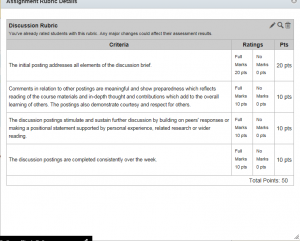Supporting college students to develop critical thinking skills is an overarching goal in higher education. Students with developed critical thinking skills have the ability to evaluate their own arguments as well as others, resolve conflicts, and generate well-reasoned resolutions to complex problems (Behar-Horenstein & Niu, 2011). Given that there is an exponential increase in the information and knowledge being generated, possessing critical thinking skills fulfills the goal of nurturing students to become responsible citizens in a complex society.
According to a national survey, nearly a third of all higher education students in the United States took at least one course online in 2012 (Allen & Seaman, 2013). Online discussions are often used to encourage students to critically think and engage with one other (Cox & Cox, 2008). However, mixed findings have been found about the effectiveness of online discussions in stimulating critical thinking (Celentin, 2007; Darabi, Arrastia, Nelson, Cornille, & Liang, 2011). In addition, the “limited responsiveness and interactivity found in many online discussions suggests a lack of attention to the ideas of others” (Wise, Speer, Marbouti, & Hsiao, 2013, p. 324). Several elements have been identified in previous research that guide an effective online discussion, namely requiring student participation, offering structured prompts (such as debate or problem-based), and providing prompt but modest instructor facilitation (see deNoyelles, Zydney, & Chen, 2014). It is advised to simultaneously utilize these strategies to form a guided approach in order to support students to not only critically think, but meaningfully engage with one another as well.
Link to example artifact(s)
Example #1
Instructor: Rohan Jowallah, Instructor, African-American Studies, College of Arts and Humanities, UCF
Course Title: AFA3102 – Introduction to Africana Studies
This discussion was designed to allow students to develop critical thinking in relation to contemporary issues within the African American community. In the designed the instructor used a video to make social connections to motivate and sustain students’ participation in the online discussion. A description of the discussion requirements was given to students. In the description, advance guidance was provided to ensure students engaged critically. A detailed rubric (Figure 1) was provided that gave students specific areas that would be considered for grading. All three artifacts (discussion brief) [Figure 2], video [Figure 2] and rubric included within the discussion, were aimed at encouraging critical thinking and responses within the online learning environment. For the design of this discussion, the instructors considered Gao et al. (2009) model of discussion called “Productive Online Discussion”. By using this model, the instructors were able to give consideration to components for improved understanding of course content, development of critical thinking skills, construction of knowledge and the sharing of knowledge. The results from the strategy suggest instructors must take time to design discussions which make connections to social/contemporary issues as well as provide guidance that will elicit and encourage critical thinking. A student sample is provided in Figure 3.

Figure 1 Discussion Rubric

Example #2
Instructor: Ernest Nkansah-Dwamena, Visiting Assistant Professor, College of Environmental Science and Forestry, SUNY
Course Title: Sustainable Systems Thinking
A good discussion prompt should not only be open-ended and allow for multiple perspectives on the topic but should also consider students’ prior knowledge and be directly linked to the learning objective (Aloni & Harrington, 2018). The literature also emphasizes the need for instructors to be actively involved in students’ learning (Arend, 2009; Brookfield, 2011). Nevertheless, excessive instructor participation in the discussion forum can potentially limit student’s participation and hamper critical learning (Abrami et al. 2008; Mandernach et al., 2009).
In my Sustainable Systems Thinking course, students have reported application activities like interviewing neighbors about their views on sustainability deepens their understanding of sustainability which in turn enables them to engage in thoughtful and provocative discussion with their classmates in the discussion forum. I use a multi-level question for my discussion prompts. Usually, I start my discussion prompts with very basic level questions, asking about knowledge to ensure students are comfortable in the discussion before advancing to higher order thinking questions. These higher order thinking questions put advanced cognitive demand on the students. They motivate students to think beyond literal questions promote critical thinking skills because these types of questions expect students to apply, analyze, synthesize, and evaluate information instead of simply recalling facts (Shea, Pickett, & Pelz, 2003).
Discussion Prompt Example
An elevator speech is a concise summary that you can convey within one-minute elevator trip. If you were in a checkout line at a market, you mentioned to the clerk that you are studying sustainability, and the clerk said to you, “Sustainability? What is that?” What would you say? Write a couple of concise sentences that give a quick, comprehensible overview, understandable by someone to whom the subject is unfamiliar and discuss the basic concepts of sustainability and why you think it is important. You should draw on your related life experiences, professional opinions, and information from the readings, videos, and the sustainability interview you conducted to inform your discussion. In your replies, consider how your definition compares with your classmates’ and other established definitions in the reading and media content we have covered this module (week).
The discussion prompt above challenges students as they move up in Bloom’s Taxonomy. The learning materials for this module’s discussion include the following:
- Reading: White, Mark A. “Sustainability: I know it when I see it.” Ecological Economics, 86, (2013).
- Video: The Need to Achieve the Sustainable Development Goals in Papua New Guinea (7:15 minutes)
- Global Survey on Sustainability and the SDGs
- Sustainability interview questions for students
Facilitating
Facilitating online discussions requires students to know their expectations (Bernstein & Isaac, 2018). Besides describing expectations, I provide a rubric, and demonstrate or model to students what constitutes a substantive post. My discussion prompts also solicit student’s personal opinion and experience. However, for a post to be considered substantive, I make it clear to students that it must originate from the course content. For example, where I find a disconnect between student’s post and the concept or topic under discussion, I would say something like, this is a great idea, but “Can you explain or link it to the course content?” Or “What information can you pull from the text, lecture, or video that would help substantiate your point?” or “Can you provide a piece of evidence to support your view” or Could you provide clear examples?” or “Can you explain your reasoning behind this to us?” For students to get the highest grade on a post, I require them to cite outside resources—the text, a journal article, or a reputable website.
Link to scholarly reference(s)
Abrami, P. C., Bernard, R. M., Borokhovski, E., Wade, A., Surkes, M., Tamim, R., & Zhang, D. (2008). Instructional interventions affecting critical thinking skills and dispositions: A stage 1 meta-analysis. Review of Educational Research, 78, 1102-1133.
Allen, I. E., & Seaman, J. (2013). Changing course: Ten years of tracking online education in the United States. Babson Park, MA: Babson Survey Research Group and Quahog Research Group. http://www.onlinelearningsurvey.com/reports/changingcourse.pdf
Aloni, M., & Harrington, C. (2018). Research-based practices for improving the effectiveness of asynchronous online discussion boards. Scholarship of Teaching and Learning in Psychology, 4(4), 271.
Arend, B., (2009). Encouraging critical thinking in online threaded discussions. The Journal of Educators Online, 6(1).
Behar-Horenstein, L.S., & Niu, L. (2011). Teaching critical thinking skills in higher education: A review of the literature. Journal of College Teaching & Learning, 8(2), 25-41.
Bernstein, A. G., & Isaac, C. (2018). Critical thinking criteria for evaluating online discussion. International Journal for the Scholarship of Teaching and Learning, 12(2), 11.
Brookfield, S. D., (2011). Teaching for critical thinking: Tools and techniques to help students question their assumptions. San Francisco, CA: Jossey-Bass.
Celentin, P. (2007). Online education: Analysis of interaction and knowledge building patterns among foreign language teachers. The Journal of Distance Education, 21(3), 39-58. http://www.jofde.ca/index.php/jde/article/view/29/35
Cox, B., & Cox, B. (2008). Developing interpersonal and group dynamics through asynchronous threaded discussions: The use of discussion board in collaborative learning. Education, 128(4), 553-565.
Darabi, A., Arrastia, M. C., Nelson, D. W., Cornille, T., & Liang, X. (2011). Cognitive presence in asynchronous online learning: A comparison of four discussion strategies. Journal of Computer Assisted Learning, 27(3), 216-227.
deNoyelles, A., Zydney, J., & Chen, B. (2014). Strategies for creating a community of inquiry through online asynchronous discussions. Journal of Online Learning and Teaching, 10(1), 153-165. http://jolt.merlot.org/vol10no1/denoyelles_0314.pdf
Gao, F., Wang, C., & Sun, Y. (2009). A new model of productive online discussion and its implications for research and instruction. Journal of Educational Technology Development and Exchange, 2(1).
Mandernach, B. J., Forrest, K. D., Babutzke, J. L., & Manker, L. R. (2009). The role of instructor interactivity in promoting critical thinking in online and face-to-face classrooms. MERLOT Journal of Online Learning and Teaching, 5(1).
Shea, P. J., Pickett, A. M., & Pelz, W. (2003). A follow-up investigation of “teaching presence” in the SUNY learning network. Journal of Asynchronous Learning Networks, 7(2).
Wise, A., Speer, J., Marbouti, F., & Hsiao, Y. (2013). Broadening the notion of participation in online discussions: Examining patterns in learners’ online listening behaviors. Instructional Science, 41, 323-343.
Citation
Jowallah, R.,deNoyelles, A., & Nkansah-Dwamena, E. (2015). Use a guided approach to support critical thinking in online discussions. In B. Chen & K. Thompson (Eds.), Teaching Online Pedagogical Repository. Orlando, FL: University of Central Florida Center for Distributed Learning. https://topr.online.ucf.edu/using-a-guided-approach-to-support-critical-thinking-in-online-discussions/.
[2] Nkansah-Dwamena, E. (2015). Use a guided approach to support critical thinking in online discussions. In B. Chen & K. Thompson (Eds.), Teaching Online Pedagogical Repository. Orlando, FL: University of Central Florida Center for Distributed Learning. https://topr.online.ucf.edu/using-a-guided-approach-to-support-critical-thinking-in-online-discussions/.
